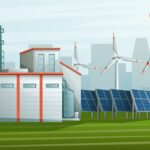In recent years, renewable energy has emerged as a powerful solution to reduce carbon emissions and create a more sustainable future. However, as more solar panels, wind turbines, and other renewable sources are installed worldwide, energy companies face a unique challenge: managing and optimizing a complex, variable power supply. This is where Artificial Intelligence (AI) and Big Data come into play, helping to advance renewable energy in ways never before possible. Let’s explore how AI and Big Data are driving efficiency, reliability, and growth in the renewable energy sector.
In recent years, renewable energy has emerged as a powerful solution to reduce carbon emissions and create a more sustainable future. However, as more solar panels, wind turbines, and other renewable sources are installed worldwide, energy companies face a unique challenge: managing and optimizing a complex, variable power supply. This is where Artificial Intelligence (AI) and Big Data come into play, helping to advance renewable energy in ways never before possible. Let’s explore how AI and Big Data are driving efficiency, reliability, and growth in the renewable energy sector.
Predicting Energy Production with Precision
Renewable energy sources like solar and wind are highly dependent on weather conditions, which are often unpredictable. This variability can make it difficult to forecast how much energy will be generated on any given day. AI-powered algorithms, however, can analyze weather patterns, historical data, and other environmental factors to predict energy production more accurately. By using machine learning models that continuously learn from new data, energy providers can make reliable forecasts, even accounting for sudden changes in weather.
With better predictions, energy companies can:
- Plan energy distribution more effectively
- Reduce the need for backup from non-renewable sources
- Lower costs and maintain consistent energy supply for users
Optimizing Energy Storage Systems
One of the biggest challenges in renewable energy is energy storage. Solar panels and wind turbines don’t generate power around the clock, so energy companies need effective storage solutions to ensure power is available when demand is high. AI and Big Data are transforming how these storage systems operate by:
- Monitoring energy levels in real time
- Predicting demand surges and dips
- Identifying the best times to store or release energy
AI can decide when stored energy should be used, keeping the power grid balanced and reducing waste. Advanced storage solutions powered by AI help make renewable energy a more reliable option for large-scale applications.
Enhancing Grid Management and Stability
Renewable energy sources, when scaled up, can place a strain on traditional power grids. Power grids were initially designed for consistent energy sources, like coal or natural gas, that produce a steady output. However, renewable energy is more variable and can cause fluctuations that disrupt the grid. AI-driven grid management tools can step in to help balance this supply by:
- Automatically adjusting output levels based on real-time demand
- Redirecting power across different areas to avoid overloads
- Predicting and preventing potential grid failures
With the help of AI, grid operators can manage the fluctuating supply of renewable energy more effectively, ensuring that homes, businesses, and critical infrastructure have stable access to power.
Improving Efficiency in Solar and Wind Farms
AI and Big Data play a crucial role in optimizing solar and wind farm operations. Using AI-powered sensors and data analysis, operators can monitor each turbine or solar panel’s performance. AI systems can:
- Detect early signs of wear or malfunction
- Schedule maintenance only when needed (predictive maintenance)
- Adjust the positioning of wind turbines or solar panels for optimal energy capture
This optimization not only enhances the efficiency of renewable farms but also extends the lifespan of the equipment, helping companies get the most out of their investment and minimize repair costs.
Driving Cost Savings and Reducing Emissions
Implementing AI and Big Data allows renewable energy companies to make smarter, data-driven decisions that reduce operational costs. For example, energy providers can minimize energy waste, reduce dependency on fossil-fuel-powered backup, and lower the cost of energy production. Over time, these efficiencies can translate to reduced energy costs for consumers and a lower carbon footprint for the entire energy sector.
AI’s ability to analyze and manage vast amounts of data ensures that renewable energy systems can work as efficiently and cleanly as possible. By making each step of energy generation, storage, and distribution more efficient, AI helps drive down costs and carbon emissions.
Encouraging More Widespread Adoption of Renewable Energy
Finally, as AI and Big Data make renewable energy systems more reliable and cost-effective, it becomes easier for businesses, governments, and even individual consumers to adopt renewable energy. By lowering costs and improving reliability, AI technology is paving the way for more people to choose sustainable energy options.
Future Outlook: AI’s Expanding Role in Renewable Energy
The impact of AI and Big Data on renewable energy is only beginning. As these technologies continue to evolve, we can expect even more breakthroughs in areas like autonomous grid management, real-time energy trading, and smart city integrations. In the future, AI may empower self-sustaining microgrids that produce, store, and distribute energy locally, reducing dependency on large power grids and making energy even more accessible.
AI and Big Data are transforming the renewable energy industry, making it smarter, more efficient, and reliable. By improving forecasting, optimizing energy storage, stabilizing grids, and reducing costs, these technologies make renewable energy a more practical and scalable solution for a sustainable future. As advancements continue, AI’s role in renewable energy will only grow, bringing us closer to a world powered by clean, renewable sources.



